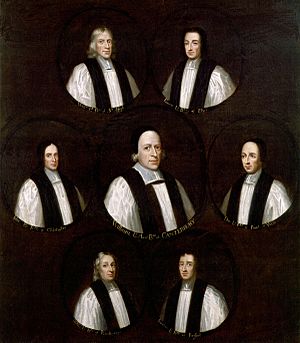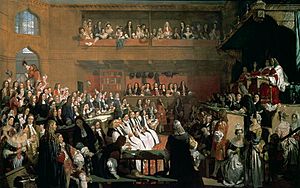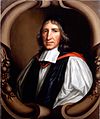Seven Bishops facts for kids
The Seven Bishops were important leaders of the Church of England. In June 1688, they were put on trial but found innocent. They had been accused of writing something that stirred up trouble against King James II. This event was a big part of what led to the Glorious Revolution in November 1688. During this revolution, King James II was removed from power.
In November 1685, King James II closed down the Parliament of England. This was because Parliament refused to pass laws that would remove rules against Catholics and other Protestants called Nonconformists. The Parliament of Scotland faced the same fate in August 1686. Neither Parliament met again until 1689.
In April 1687, King James II issued a special order called the Declaration of Indulgence. This order aimed to give religious freedom. However, many people in both England and Scotland were against it. Even many Nonconformists worried it would harm their chances of rejoining the Church of England later.
The King reissued the Declaration in April 1688. He then ordered all bishops to read it in every church in England. The seven bishops asked to be excused from this order. They argued that the order relied on the King's power in a way that Parliament had already said was illegal. After their request was printed and shared widely, the bishops were accused of stirring up trouble against the King. They were held in the Tower of London. On June 30, they were tried and found not guilty.
Most Protestants were okay with King James being Catholic himself. This was because he seemed unlikely to have more children. His heir was his Protestant daughter, Mary II of England. But on June 10, his son, James Francis, was unexpectedly born. This meant there was now a chance of a Catholic family ruling England for a long time. Many saw the bishops' trial as part of a bigger attack on the Church of England. After the bishops were found innocent, there were protests against Catholics across England and Scotland. This eventually led to King James being removed from power in November 1688. However, five of the seven bishops later lost their jobs. They refused to promise loyalty to the new rulers.
Contents
Why the Trial Happened
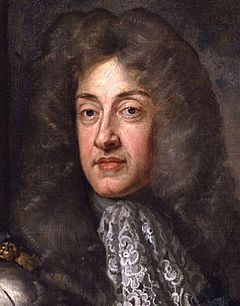
Even though he was Catholic, James II became king in February 1685 with a lot of support. Rebellions in England and Scotland were quickly defeated. But less than four years later, he was forced to leave the country. People often talk about religious freedom as the main reason. However, historians usually see it as part of a long fight between the King and Parliament. This fight had been going on for a hundred years.
The timing of James's actions was also bad. In October 1685, France took away religious freedom for French Protestants called Huguenots. Between 200,000 and 400,000 of them had to leave France. About 40,000 settled in London. Also, 2,000 Vaudois Protestants were killed in 1686. France's power was growing under King Louis XIV. These events made Protestants in Europe fear a Catholic takeover.
There were two main parts to the laws against certain religions. The first was the right to worship privately. This rule was often not strictly followed. Special permissions were given out regularly. This was because there were not many Catholics. In 1680, less than 1% of English people were Catholic. About 4% were Protestant Nonconformists.
The second part was the Test Act. This law said that all government officials had to follow the beliefs of the Church of England. Many people were okay with private worship. But they saw the Test Act as very important. The king had a special power to excuse people from some laws. But this power could be taken away at any time. A law passed by Parliament, however, was much stronger.
What Happened Step by Step
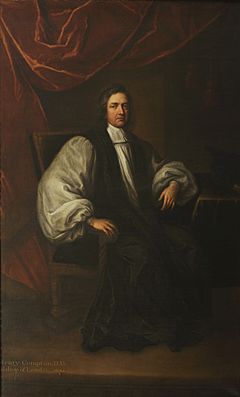
The Declaration of Indulgence was first issued in Scotland on February 12, 1687. Then it came out in England on April 4. Many people did not like it, but they did not openly fight it. Still, its political meaning caused a lot of discussion.
As king, James himself did not have to follow the Test Act. He could also "dispense" or excuse individuals from it. This power was meant for special cases. But James used it a lot to put Catholics in important jobs in the army and government. He even fired judges who disagreed with his use of this power. In 1686, he got a court ruling in his favor. Few people challenged this old rule. But people feared things becoming unstable. They relied on the law to keep order. So, James's actions caused anger and worry. This was true even for people who benefited. For example, Sir John Shorter, a Nonconformist, was chosen by James to be Lord Mayor of London in 1687. Before taking office, he insisted on following the Test Act. He reportedly did this because he "distrusted the King's favor."
The Declaration also basically got rid of a law. Only Parliament had the right to do this. This right had been confirmed in 1663 and 1673. Also, even if James was above the law, his people were not. They were being told to ignore the law and their promises of office. This would make them guilty of perjury. At that time, this was seen as both a crime and a sin.
These issues led to big debates. One of the strongest opponents was a London priest named William Sherlock. The Declaration was reissued in April 1688. On May 4, James ordered it to be read in every church. It was to be read in London on May 20 and 27. Then, it would be read elsewhere on June 3 and 10. The King wanted to force the Church of England to publicly support getting rid of the Test Act.
In several meetings, the London church leaders voted strongly against obeying. On May 13, William Sancroft, the Archbishop of Canterbury, and seven other bishops decided to go against James's order. These bishops included Henry Compton, Francis Turner, Thomas White, Thomas Ken, John Lake, Jonathan Trelawny, and William Lloyd. The Bishops of Winchester, Gloucester, and Norwich also agreed with this plan. Bishop Compton had already been suspended. This was because he refused to stop John Sharp from preaching an anti-Catholic sermon. The other seven bishops signed a request asking to be excused. They referred to Parliament's decisions from 1663 and 1673.
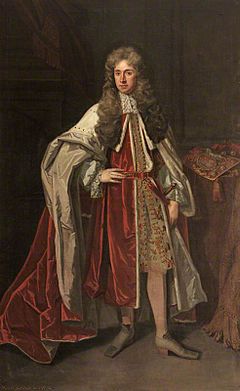
James received the request on May 18. He became very angry about being opposed. He called it "a standard of rebellion." He dismissed the bishops, saying he expected to be obeyed. Within hours, copies of the bishops' request were being sold in London. People said Compton was the one who started it.
On May 20, only seven churches in London read the Declaration. In at least three of them, the people walked out. None of them read it on May 27. Across the country, only 200 out of 9,000 churches read it. Even worse for James, many Nonconformists supported the Church of England's decision not to obey.
Important government advisors, like the Earl of Melfort, said that printing the bishops' request was like stirring up trouble against the king. He urged James to put the bishops on trial. A special church court refused to take the case. Lord Jeffreys, a top judge, advised against the trial. But James overruled him. James told the bishops to appear before him on June 8 to explain themselves. They did, but refused to answer. They said that "no Subject was bound to accuse himself." They were ordered to appear in court on June 15. When asked to pay bail, they said they were special as peers and offered their word instead. James lost his temper and ordered them to be held in the Tower of London.
There was little proof that the bishops meant to cause such a big reaction. But their arrest was a huge public relations disaster for James. When the bishops were taken to court on June 15, huge crowds went with them. Twenty-one noblemen showed up, offering to pay bail if needed. Among them were Danby and James's brother-in-law Clarendon. A Quaker, a type of Nonconformist, even offered bail for Bishop Ken. Quakers were usually very supportive of James.
The Trial of the Bishops
The trial happened at the Court of King's Bench on June 29. James was sure he would win. He had removed and replaced many judges over the past three years. So, the courts were mostly filled with people loyal to him. The jury was chosen by the Sheriffs of the City of London. It included several former Dissenters and government workers.
However, among the four judges, Powell and Holloway clearly supported the bishops. The main judge, Wright, was "unusually moderate." And Richard Allibond was fair.
The lawyers for the bishops argued that their request simply confirmed a rule made by Parliament. So, it could not be considered something that stirred up trouble. When the judges gave their final advice to the jury, three of them did not say if James had the right to use his special power. They focused only on whether the petition was harmful. Wright and Allibond said it was. Powell and Holloway said it was not. Holloway even asked the jury to think about whether the bishops were right to say the king's power was illegal. The jury was reportedly ready to say "not guilty" right after the trial. But two members who worked for James delayed the decision until the next morning.
The decision to put the bishops on trial was a political disaster for the government, no matter the outcome. It was made worse by how poorly the king's lawyers handled the case. One historian called it "grotesque." When the bishops were found innocent, there were huge celebrations across London. Even soldiers in the English Army cheered, which made James very annoyed and worried.
What Happened After

The birth of James Francis on June 10 meant that a Catholic family might rule England for a long time. The trial also led to many protests against Catholics in England and Scotland. These events together are often seen as a major turning point.
James's main advisor, the Earl of Sunderland, was worried about how unpopular the king was. He was clearly shaken by the angry reactions he got when he attended the trial. On the same day, a special Invitation was sent to William of Orange. It "invited" him to take the throne for his wife Mary. Mary was James's Protestant daughter. The invitation was written by Henry Sydney. It was signed by the Immortal Seven. These were important people whose support William needed to invade England.
After the Glorious Revolution in November 1688, nine bishops refused to swear loyalty to the new rulers. Five of these were from the Seven Bishops: Sancroft, Ken, Lake, Turner, and Lloyd. William Sherlock was one of 400 church leaders who did the same. However, like many others, he was later allowed back into the church. Most of them refused out of their beliefs, not because they were against the new rulers. Their removal actually made the church more open-minded. The Toleration Act 1689 gave freedom of worship to Nonconformist Protestants. The Occasional Conformity Act 1711 allowed Catholics and others to avoid big fines.
The Seven Bishops
-
Thomas Ken, Bishop of Bath and Wells
-
John Lake, Bishop of Chichester
-
William Lloyd, Bishop of St Asaph


